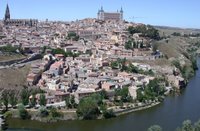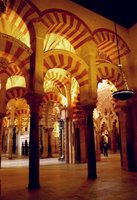
My Trip to Spain
by Elmedina Podrug, presentation 0n 21 March 2006
I’ll try to describe my wonderful trip to Spain that I made at the end of last year. I stayed for a week in Madrid from where I went to Toledo and Cordoba to spend a day in each. I was very much attracted by these two cities, especially since I had been to Granada and fell in love with Andalusia, the southern province of Spain. And I also wanted to learn more about the exile of Jews and Maures, Spanish Muslims, who had been expelled from Spain in the fifteenth and sixteenth centuries and who had taken refuge in Bosnia.
Madrid is not a capital like Paris or London. Its architecture is very diverse and its location does not make the visit easier if you have only a few days at your disposal. You have to reduce the list of monuments and museums you want to see. I would recommend that you go and spend a day in the Prado museum which offers a great number of paintings from almost all periods and in all styles. An entire floor is dedicated to Velasquez, the most popular and cherished painter of the Spanish court. El Greco is another famous Spanish painter who actually came from the Greek island of Crete to live in Toledo where his house and studio are still preserved.
Toledo (see image above), which enchanted me as no any other city before, was a real revelation. When I got off the train I was dazzled by its large medieval ochre walls that seem to be covered with some fine gold dust. I learnt that Visigoths, a Germanic tribe coming from the East of Europe, had their settlements there before the Islamic invasion of the Iberian Peninsula. The archaeological sites were excavated close to the medieval ramparts and the magnificent crown, pieces of golden jewellery as well as everyday objects were found. You can see them in the archaeological museum in Madrid.
Before the Inquisition, Toledo was, just like Sarajevo, an example of peaceful and flourishing coexistence of three religious communities: Jewish, Muslim and Catholic. There are still some cultural and historic traces of the two expelled communities, such as a small mosque at one of the numerous town gates, and a synagogue transformed into a Sephardic museum that was restored and opened in 1910. Its interior walls are covered with historical and biblical inscriptions and, in spite of having lost part of the original polychrome, much of the green, blue, red, orange and black colours remain the same.
My other trip from Madrid was to Cordoba. The journey by high-speed train took about two hours. It is the authentic Spanish South with its never ending olive tree groves, small white-washed houses and clusters of geranium dangling down the walls. Cordoba was the only Caliphate in the West of Europe. It was much sought after by some Christian kings who established their temporary residence there. The city gave a few great names to philosophy, medicine and astronomy, such as Averroes and Maimonides.
In 1994 UNESCO declared part of Cordoba historical centre as a World
 Heritage site. The city`s most famous monument is the Mezquita (left), a mosque-cathedral whose uniqueness lies in the integration of a Christian cathedral within a magnificent Muslim building.
Heritage site. The city`s most famous monument is the Mezquita (left), a mosque-cathedral whose uniqueness lies in the integration of a Christian cathedral within a magnificent Muslim building.The first caliph of Andalusia ordered the minaret to be built in the middle of the Orange tree court. Byzantine and Baghdad artists worked hand in hand with the Cordobans to create this outstanding place of worship. At the end of my visit, in the dim evening light, I could admire the Christian King`s Alcazar, a medieval building which housed different royal dynasties. Inside its walls there is an exhibition of Roman mosaics, caliphal public baths and a magnificent courtyard with Moorish style fountains and gardens.
I’ll probably return to those two Spanish cities that are teeming with historical and cultural monuments.



No comments:
Post a Comment